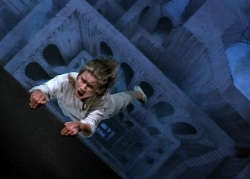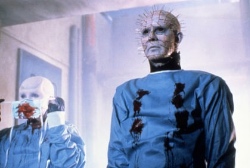
 One of the weapons utilized in Scream for Help is a Swiss Army knife — fitting for the film’s all-purpose refusal to commit to one genre. Ultimately, it’s a thriller, as sleazy as it cheesy. Would you expect anything less from Death Wish director Michael Winner?
One of the weapons utilized in Scream for Help is a Swiss Army knife — fitting for the film’s all-purpose refusal to commit to one genre. Ultimately, it’s a thriller, as sleazy as it cheesy. Would you expect anything less from Death Wish director Michael Winner?
At 17, Christie Cromwell (Rachael Kelly) is a regular Nancy Drew in Guess jeans. As she details in her diary (and narrates to us), she’s convinced her stepdad, Paul (David Allen Brooks, The Kindred), is trying to kill her mother (Marie Masters, Slayground) for her wealth. As becomes irrefutable with each increasingly ludicrous scenario, she’s not wrong.
 After the film devotes about an hour to Christie’s snooping and sleuthing, screenwriter Todd Holland (1985’s Fright Night) turns the tables into a siege picture, as Paul and his posse trap the Cromwell ladies in their own house. Luckily, Christie holds the home-court advantage, although throughout Help, the girl is at turns crafty and clumsy, per the needs of the story beats, and Kelly (who never graced a movie before or since) makes an impression as the bratty but well-meaning heroine.
After the film devotes about an hour to Christie’s snooping and sleuthing, screenwriter Todd Holland (1985’s Fright Night) turns the tables into a siege picture, as Paul and his posse trap the Cromwell ladies in their own house. Luckily, Christie holds the home-court advantage, although throughout Help, the girl is at turns crafty and clumsy, per the needs of the story beats, and Kelly (who never graced a movie before or since) makes an impression as the bratty but well-meaning heroine.
Having recruited Led Zeppelin’s Jimmy Page to score Death Wish II two years prior, Winner this time procures Zep’s John Paul Jones to provide the soundtrack. But it also finds Winner returning to the well for his reputation of being cruel to his female characters. The nudity required of Lolita Lorre (as Paul’s mistress) is udderly utterly humiliating, and when Christie loses her virginity (to her BFF’s BF, played by How I Got into College’s Corey Parker), she emerges from the sheets in horror at the amount of blood — and no wonder, as it appears she has pressed her palm into a full tray of red paint. One wonders if Winner cackled at himself for costuming the underage girl in a shirt emblazoned with the word “MUFFS.” (Probably.)
There’s another thing one wonders, as Christie relies on a bicycle and Polaroid camera as her tools of reconnaissance: What would Brian De Palma do? Better, to be certain, but I’d be lying to suggest I didn’t thoroughly enjoy Scream for Help as is. —Rod Lott


 Two moderately appealing lovers frolic on the shore, playing guitars and rejecting sexual advances, but something monstrous is waiting for them in the water. To the similar-sounding cues from a
Two moderately appealing lovers frolic on the shore, playing guitars and rejecting sexual advances, but something monstrous is waiting for them in the water. To the similar-sounding cues from a 







 Since having a stroke over a year ago, I’ve lost close to 200 pounds. And, even though I’m considerably older than the titular Brittany in Brittany Runs a Marathon, how the world’s opinion changes — for good and bad — when you drastically change yourself is so honestly depicted here that, unless you’ve been through it, you’ll probably never understand.
Since having a stroke over a year ago, I’ve lost close to 200 pounds. And, even though I’m considerably older than the titular Brittany in Brittany Runs a Marathon, how the world’s opinion changes — for good and bad — when you drastically change yourself is so honestly depicted here that, unless you’ve been through it, you’ll probably never understand. The tribulations that Brittany goes through to get to the marathon, from dealing with random food binges to mysterious leg pains to an Instagram roommate who tells her she be fat again soon, is an earnest account of an unhealthy person trying to change not only her outer self, but her inner self as well. That being said, it is also dramatically funny at times when it doesn’t intrinsically hurt.
The tribulations that Brittany goes through to get to the marathon, from dealing with random food binges to mysterious leg pains to an Instagram roommate who tells her she be fat again soon, is an earnest account of an unhealthy person trying to change not only her outer self, but her inner self as well. That being said, it is also dramatically funny at times when it doesn’t intrinsically hurt.